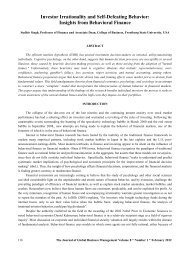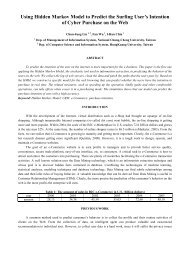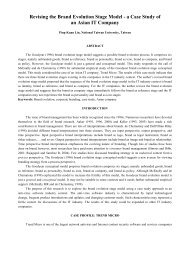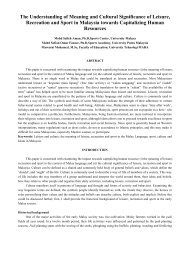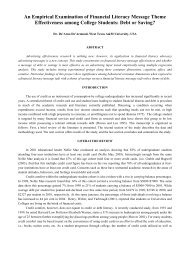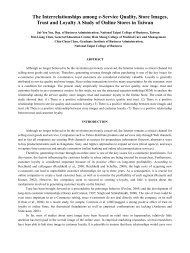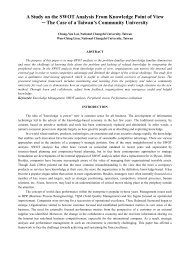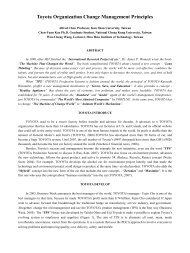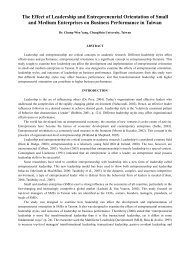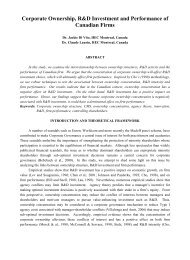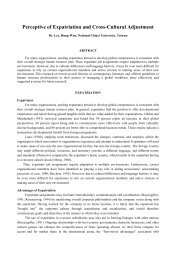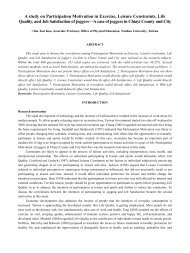Organizational Climate as a Predictor to Job Satisfaction of ... - JGBM
Organizational Climate as a Predictor to Job Satisfaction of ... - JGBM
Organizational Climate as a Predictor to Job Satisfaction of ... - JGBM
You also want an ePaper? Increase the reach of your titles
YUMPU automatically turns print PDFs into web optimized ePapers that Google loves.
<strong>Organizational</strong> <strong>Climate</strong> <strong>as</strong> a <strong>Predic<strong>to</strong>r</strong> <strong>to</strong> <strong>Job</strong> <strong>Satisfaction</strong> <strong>of</strong> NewFaculties in Three Public Universities <strong>of</strong> MalaysiaNor Wahiza Abdul Wahat, Ph. D, University Putra MalaysiaABSTRACTAttached <strong>to</strong> three public which are also research universities <strong>of</strong> Malaysia, a <strong>to</strong>tal <strong>of</strong> 117 new faculties fromvarious social and hard sciences disciplines have been investigated <strong>to</strong> draw upon important findings on their perceivedorganizational and job satisfaction levels, <strong>as</strong> well <strong>as</strong> the influence that their perceived organizational climate h<strong>as</strong> on jobsatisfaction. A survey b<strong>as</strong>ed on the conceptual framework which integrated the Theory <strong>of</strong> Work Adjustment (Dawis andL<strong>of</strong>quist, 1984) and Person-Environment Perspective w<strong>as</strong> conducted <strong>to</strong> meet the objectives <strong>of</strong> the study. Data wereanalyzed using descriptive, Pearson correlation and simple regression analyses. Results showed that most new facultiesembraced high level <strong>of</strong> perceived organizational climate but moderate job satisfaction levels. There w<strong>as</strong> a significant,positive relationship between perceived organizational climate and job satisfaction. Both the relationship climate anddevelopment climate dimensions correlated significantly with job satisfaction. Perceived organizational climate w<strong>as</strong>further identified <strong>as</strong> predic<strong>to</strong>r <strong>of</strong> job satisfaction for new faculties serving in the three public, research universities.B<strong>as</strong>ed on the findings, it is highly recommended for the universities <strong>to</strong> adopt non-formal men<strong>to</strong>ring system <strong>as</strong> aneffective organizational mechanism <strong>to</strong> establish and sustain harmonious relationships between new faculties and theirsenior colleagues.INTRODUCTIONNew faculty members are always in the struggle <strong>of</strong> adjusting <strong>to</strong> their new roles, multiple job demands andorganizational socialization. Being attached <strong>to</strong> the public, research universities in Malaysia, where such designationcomes with the package <strong>of</strong> an additional RM 100 million for research, development and commercialization activities,this particular group is not only expected <strong>to</strong> juggle with heavy demands <strong>of</strong> doing research and publications, but also <strong>to</strong>conduct the cl<strong>as</strong>sical business <strong>of</strong> teaching, supervision, administrative t<strong>as</strong>ks, consultancy, community services and labor clinical responsibilities (depending on their fields <strong>of</strong> expertise).Despite such high expectations on the ability <strong>of</strong> new faculties <strong>to</strong> perform excellently for their research universities,there have been reports on new faculties’ weaknesses in research proposal development, theses supervision andscientific writings. Newspaper reports on the need <strong>to</strong> review curricular syllabus and <strong>to</strong> incre<strong>as</strong>e research or journalarticles (Utusan Malaysia 2005) again indicated the need for new faculties <strong>to</strong> improve their performances. Reportedphenomenon on job dissatisfaction <strong>of</strong> a group <strong>of</strong> new faculties <strong>to</strong>wards their work environment and several weaksubsystems such <strong>as</strong> the technical support, facilities support and maintenance systems (Sohail et al., 2003) createdquestion marks on the extent <strong>to</strong> which organizational climate and work environment <strong>of</strong> the public universities areperceived by new faculties <strong>as</strong> helpful and effective enough <strong>to</strong> guide them <strong>to</strong>wards smooth career transition anddevelopment. Despite the accountability <strong>of</strong> the universities’ managements’ <strong>to</strong> provide supportive and constructive workenvironment for the development <strong>of</strong> new faculties’ skills, competencies and creativity, the reported dissatisfaction h<strong>as</strong>created the need <strong>to</strong> investigate the extent <strong>to</strong> which the universities are playing their role in providing and nurturing suchenvironment for new faculties. In reference <strong>to</strong> the above discussions, several research questions have been welldeveloped. First <strong>of</strong> all, at what level do new faculties in the research universities in Malaysia perceive that theirorganizational climate is supportive <strong>of</strong> their growth <strong>as</strong> new faculties? Second, what is the job satisfaction level <strong>of</strong> thenew faculties, especially in relation <strong>to</strong> their satisfaction <strong>to</strong>wards the research-oriented environment. And l<strong>as</strong>t but not thele<strong>as</strong>t, is there any relationship at all between perceived organizational climate and job satisfaction <strong>of</strong> the new faculties?
Hence, it would be very interesting <strong>to</strong> look at the current perceived organizational climate, job satisfaction leveland relationship between the two fac<strong>to</strong>rs for new faculties in the three identified research universities in Malaysia. Theproposed hypotheses for this study were (1) There is no significant difference in the perceived organizational climate <strong>of</strong>male and female new faculties in the three public, research universities; (2) There is no significant difference in the jobsatisfaction <strong>of</strong> male and female new faculties in the three public, research universities; and (3) There is a positive,significant relationship between perceived organizational climate and job satisfaction <strong>of</strong> new faculties in the threepublic, research universities.REVIEWED LITERATURE ON ORGANIZATIONAL CLIMATE AND JOB SATISFACTIONThe Concept <strong>of</strong> <strong>Organizational</strong> <strong>Climate</strong>One <strong>of</strong> earliest definition <strong>of</strong> organizational climate w<strong>as</strong> by Forehand and Gilmer (1964). According <strong>to</strong> them,organizational climate is actually a set <strong>of</strong> traits that describes an organization. It differs an organization from otherorganizations and it remains for a certain period <strong>of</strong> time. It also influences employees’ work behaviour in that particularorganization. This w<strong>as</strong> supported by Litwin and Stringer (1968). For them, an individual’s direct perception on his orher work environment would definitely influence the individual’s motivation and work behavior. Campbell, Dunnette,Lawler and Weick (1970) explained organizational climate by dividing it in<strong>to</strong> two attributes. The first one refers <strong>to</strong> a se<strong>to</strong>f attributes that explains the patterns <strong>of</strong> interaction and actions that organizations adopted in dealing with its employees.The second attribute refers <strong>to</strong> individual’s expectations <strong>to</strong>wards his or her organizations. Such expectations usuallyinfluences the individual’s work behavior.Meanwhile Schneider and Synder’s (1975) <strong>to</strong>ok a more detailed and different approach in defining organizationalclimate. They refer <strong>to</strong> the concept <strong>as</strong> a frame <strong>of</strong> reference on the congruence <strong>of</strong> work behaviors and procedures thatexist in a system. Higher congruence between the two elements would build an employee’s perception <strong>of</strong> a moreharmonious work environment and lower congruence between the two elements would create a perception <strong>of</strong> a lessharmonious work environment. Moran and Volkwein (1992) defined the concept <strong>of</strong> organizational climate <strong>as</strong>characteristics <strong>of</strong> an organization. Those characteristics include a) the perceptions that employees share on au<strong>to</strong>nomy,trust, cohesiveness, support, appreciation, innovation and fairness that exist in their organization; b) it is generated fromorganizational members’ interactions; c) it serves <strong>as</strong> a b<strong>as</strong>ic stance for employees’ interpretations <strong>to</strong>wards certainsituations; d) it describes the norms and attitudes <strong>of</strong> an organizational culture, and l<strong>as</strong>t but not le<strong>as</strong>t e) it functions <strong>as</strong> <strong>as</strong>ource that influences individual’s work behaviors.Alternatively, Burke and Litwin (1992) defined organizational climate <strong>as</strong> individuals’ perceptions <strong>to</strong>wards theadministration or management <strong>of</strong> their work units. It is also closely related <strong>to</strong> individuals’ perceptions on their andcolleagues’ effectiveness in job and t<strong>as</strong>k implementation. Schneider et al. (1994) defined organizational climate <strong>as</strong>employees’ perceptions <strong>to</strong>wards the organizations’ work atmosphere. It is built upon individual’s observations on thepractices, procedures and rewards that persist within the organization. In other words, the organization’s policies andprocedures are very much influential in shaping an individual’s perceptions on the organizational climate that exist inhis or her work place. Schneider and Bowen (1995) defined this concept <strong>as</strong> a perception that is shared amongemployees on the important things that <strong>to</strong>ok place in an organization, which includes the managements’ supports andexpectations. Such perception is usually built along the employees’ experiences while working for the organization. In1998, Verbeke, Volgering and Hessels made a differentiation between organizational climate and organizational cultureby defining organizational climate <strong>as</strong> a reflection <strong>of</strong> the way people perceive and come <strong>to</strong> describe the characteristics <strong>of</strong>their environment, and...organizational culture reflects the ways things are done in an organization.Along with that, Chu-Hua et al. (1997) looked at organizational climate <strong>as</strong> a reflection <strong>to</strong>wards a dynamicinteraction process that involves organization’s environment, the employees and management practices. Among themost recent definition <strong>of</strong> organizational climate w<strong>as</strong> provided by Hicks-Clarke and Iles (2000). According <strong>to</strong> them, itrefers <strong>to</strong> employees’ perceptions on the rules and laws in an organization. Most <strong>of</strong> the discussed definitions <strong>of</strong>organizational climate have reflected such concept that very much relates <strong>to</strong> the element <strong>of</strong> perception or evaluationheld by an individual <strong>to</strong>wards the characteristics, organizational traits or work environment that is moulded b<strong>as</strong>ed on
social interactions or work experiences.And in return, such perception usually influences individual’s work behaviorand motivation. Hence, this concept is rather subjective and does not relate <strong>to</strong> the concrete characteristics <strong>of</strong>organizations.The Concept <strong>of</strong> <strong>Job</strong> <strong>Satisfaction</strong>In general, job satisfaction refers <strong>to</strong> a positive emotion experienced by an individual in reaction <strong>to</strong> the individual’sjob and t<strong>as</strong>k. Usually, the comparison made by an individual between an individual’s expectations and the realitycreated which generates positive results lead <strong>to</strong> what is termed <strong>as</strong> job satisfaction. On contrary, a comparison betweenexpectations and reality that lead <strong>to</strong> a perceived gap between the two triggered <strong>to</strong> what is called job dissatisfaction.In line with that, Locke (1976) h<strong>as</strong> came up with a cl<strong>as</strong>sical definition <strong>of</strong> job satisfaction <strong>as</strong> a positive emotionalstatus that resulted from an individual’s evaluation on his or her work experiences. Meanwhile, Herzberg (1976) h<strong>as</strong>categorized the sources <strong>of</strong> job satisfaction in<strong>to</strong> two groups, which are extrinsic motivation such <strong>as</strong> work place andintrinsic motivation such <strong>as</strong> appreciation and respect. There were also other views that h<strong>as</strong> explained job satisfaction <strong>as</strong>a global concept that could be me<strong>as</strong>ured <strong>as</strong> integrated feelings that relate <strong>to</strong> all job <strong>as</strong>pects (Balzer et al.1997). Amongthe identified job satisfaction <strong>as</strong>pects are satisfaction with the job itself, salary, promotion, supervision and relationshipswith colleagues. Such opinion is very parallel earlier thoughts by Brooke dan Price (1989) that h<strong>as</strong> looked at jobsatisfaction <strong>as</strong> an individual’s attitude <strong>to</strong>ward his or her work <strong>as</strong> well <strong>as</strong> Reschley and Wilson (1995) whom also lookedat job satisfaction <strong>as</strong> employee’s satisfaction in relation <strong>to</strong> his or her t<strong>as</strong>k, supervision, promotion and salary.Within the context <strong>of</strong> academia, Ni<strong>as</strong> (1989) h<strong>as</strong> defined job satisfaction <strong>as</strong> summaries from the whole amount <strong>of</strong>rewards that a faculty member gained from his or her teaching experiences. Usually, a faculty member is more satisfiedwith his or her work when fac<strong>to</strong>rs such <strong>as</strong> high academic achievements, low level <strong>of</strong> academic problems, efficientadministration and low turnover are persistent within their teaching and learning environment. A later definition byOshagbemi (2000) on job satisfaction which w<strong>as</strong> derived from his research on academics’ job satisfaction h<strong>as</strong> focusedon the concept <strong>as</strong> the attitude <strong>to</strong>wards an object, which is known <strong>as</strong> work or job. A more recent definition by Egbule(2003) w<strong>as</strong> that job satisfaction is b<strong>as</strong>ically a concept that relates <strong>to</strong> an employee’s satisfaction <strong>to</strong>wards his or her salary,promotion opportunities, supervision and intrapersonal relationships. <strong>Job</strong> security, appreciation, leadership style andattitude, physical environment, staff development programs, flexibility in delivering academic t<strong>as</strong>ks and au<strong>to</strong>nomy arealso other <strong>as</strong>pects that could be taken in<strong>to</strong> consideration in explaining an employee’s job satisfaction.B<strong>as</strong>ed on all these definitions, it could be concluded that job satisfaction is actually closely related <strong>to</strong> individual’semotions and feelings <strong>to</strong>wards certain job <strong>as</strong>pects after comparing the similarities and differences between real jobexperiences and earlier expectations related <strong>to</strong> one’s job.The Relationship Between <strong>Organizational</strong> <strong>Climate</strong> and <strong>Job</strong> <strong>Satisfaction</strong>There h<strong>as</strong> been huge amount <strong>of</strong> studies on the relationship between organizational climate and job satisfaction. Asa matter <strong>of</strong> fact, there were also studies on the role <strong>of</strong> organizational climate, particularly the relationship and supportdimension, in e<strong>as</strong>ing the process <strong>of</strong> newcomers’ adjustment <strong>to</strong> their job demands. One <strong>of</strong> them w<strong>as</strong> the study by Louis(1980) on a group <strong>of</strong> business administration graduates that were newly serving in various sec<strong>to</strong>rs. It w<strong>as</strong> found that therespondents perceived that their frequency in socializing with more experienced work colleagues and men<strong>to</strong>r-menteerelationships <strong>as</strong> the most crucial source <strong>to</strong> help them in adjusting <strong>to</strong> their job demands. It is then followed by frequency<strong>of</strong> interactions with supervisors. Formal trainings provided by their organizations are perceived <strong>as</strong> le<strong>as</strong>t effective ine<strong>as</strong>ing their work adjustment.Fisher (1985) h<strong>as</strong> studied a group <strong>of</strong> new nurses, whom have just served for six months, <strong>to</strong> examine therelationship between social support and their job satisfaction. The first questionnaire w<strong>as</strong> administered before theywork. And the second questionnaire w<strong>as</strong> administered after they started working. Social support w<strong>as</strong> me<strong>as</strong>ured byfocusing on the emotional support by colleagues and informational support from superiors or supervisors. In this study,job satisfaction w<strong>as</strong> seen <strong>as</strong> an effect <strong>of</strong> the new nurses’ work adjustment. The result <strong>of</strong> correlation analysis indicatedpositive, significant relationship between the two fac<strong>to</strong>rs. Hence, it supported previous literatures that have proposed theimportance <strong>of</strong> social support from colleagues <strong>as</strong> well <strong>as</strong> superiors on job satisfaction <strong>of</strong> new employees.
A more recent study by Cohrs et al. (2006) on the relationship between organizational climate and job satisfactionw<strong>as</strong> conducted on 1,065 German employees from three different pr<strong>of</strong>essional groups. The first sample w<strong>as</strong> 115 womenteachers and 145 male teachers. The second sample w<strong>as</strong> 82 pr<strong>of</strong>essional female employees and 241 male employees inthe business sec<strong>to</strong>r. The third sample consists <strong>of</strong> pr<strong>of</strong>essional workers from various sec<strong>to</strong>rs. The examinedorganizational climate dimensions studied were social support, au<strong>to</strong>nomy, promotion opportunity and leadership.Correlation analysis resulted in positive and significant relationship between employees’ perceptions <strong>to</strong>wards leadershipand job satisfaction level for all the three samples. For the second and third sample, it w<strong>as</strong> found that there were morepositive perception <strong>to</strong>wards social support, au<strong>to</strong>nomy and promotion. This thus contributed <strong>to</strong> higher level <strong>of</strong> jobsatisfaction.Another study by Schulte, Ostr<strong>of</strong>f and Kinicki (2006) involved 1,076 employees from 120 bank branches in theUnited States <strong>of</strong> America. The objective <strong>of</strong> the study w<strong>as</strong> <strong>to</strong> examine the influence that individual’s climate and workclimate perceptions have on job satisfaction. <strong>Job</strong> satisfaction w<strong>as</strong> me<strong>as</strong>ured using ‘Minnesota <strong>Satisfaction</strong>Questionnaire’ (Weiss et al. 1967). Among the dimensions were satisfaction <strong>to</strong>wards supervision, colleagues, rewards,work activities, work loads, promotion opportunities, job security, physical environment and interactions with clients.<strong>Climate</strong> perception w<strong>as</strong> me<strong>as</strong>ured using 94 items and work climate perceptions w<strong>as</strong> me<strong>as</strong>ured by focusing on themanagement support, organizational vision, effective and open communication, focused training, focus group, rewardsand others. Result indicated significant relationships between the two perceptions with job satisfaction level. However,work climate perception within a work w<strong>as</strong> found <strong>to</strong> be the most important predic<strong>to</strong>r <strong>to</strong> job satisfaction compared <strong>to</strong>individual’s perception <strong>to</strong>wards climate. The result <strong>of</strong> this study h<strong>as</strong> provided a new avenue on the studies <strong>of</strong>organizational climate perception, where the sharing <strong>of</strong> perception among individuals <strong>to</strong>wards their work environmentw<strong>as</strong> evidently pro<strong>of</strong>ed <strong>to</strong> play a greater role in determining job satisfaction, compared <strong>to</strong> the role <strong>of</strong> individual’s level <strong>of</strong>perception.Chathoth et al.’s (2007) study on the relationship between perceived organizational climate and job satisfactioninvolved 77 hotel employees that served in four and five stars hotels. Their perception <strong>to</strong>wards integrity, commitmentand belief within their work environment w<strong>as</strong> me<strong>as</strong>ured with nineteen items. Meanwhile their perceptions on<strong>to</strong>available strategies, support, system and training w<strong>as</strong> me<strong>as</strong>ured using six items that focused on salary, supervision andcolleagues’ support. Result <strong>of</strong> conducted correlation analysis incated a significant, positive relationship between thesubjects’ perception <strong>to</strong>wards integrity, commitment and belief within the work environment with the employees’ jobsatisfaction. The employees’ perception on service climate inclusive <strong>of</strong> available strategies, support, system and trainingwere also found <strong>to</strong> be significantly and positively correlated with their job satisfaction. Such result suggested theimportance <strong>of</strong> organizational’s role in earning employees’ sense <strong>of</strong> trust. This is because the such trust would developmore positive perceptions among employees on their organizations’ abilities <strong>to</strong> provide effective strategies, support andtrainings for them.The above discussion exhibited that most <strong>of</strong> the p<strong>as</strong>t studies have reported solid relationships betweenorganizational climate and job satisfaction. Meanwhile, social and relationship turned out <strong>to</strong> be the most popular andsignificant organizational climate dimension in explaining employees’ job satisfaction. B<strong>as</strong>ed on the results <strong>of</strong> previousstudies, it is well-proven that perceived organizational climate h<strong>as</strong> a very influential role on job satisfaction <strong>of</strong> newfaculties during their process <strong>of</strong> adjusting <strong>to</strong> the new job roles and work environment.CONCEPTUAL FRAMEWORKThis study w<strong>as</strong> conducted b<strong>as</strong>ed on the integration <strong>of</strong> Work Adjustment Theory by Dawis and L<strong>of</strong>quist (1984) andPerson-Environment Perspective. Both perspectives emph<strong>as</strong>ized on the important roles that individual differences haveon work adjustment and job satisfaction. It w<strong>as</strong> purported by these perspectives that harmonious interactions betweenindividual differences fac<strong>to</strong>rs such <strong>as</strong> perception or personality and the work environment would be able <strong>to</strong> create morepositive work behaviors such <strong>as</strong> high levels <strong>of</strong> job satisfaction and job performance.The conceptual framework illustrated in Diagram 1 below explained the relationship between perceivedorganizational climate and job satisfaction <strong>of</strong> the new faculties. It also proposed perceived organizational climate <strong>as</strong> the
predic<strong>to</strong>r <strong>to</strong> job satisfaction <strong>of</strong> the new faculties. In other words, the new faculties’ perceptions on the characteristics,traits and work environment personalities (me<strong>as</strong>ured using the Work Environment Scale) w<strong>as</strong> proposed <strong>to</strong> predict thejob satisfaction level <strong>of</strong> the new faculties. The organizational climate dimensions involved in this study were perceivedrelationship climate and perceived personal development climate. Usually the perceptions related <strong>to</strong> these twodimensions were built from the social interactions and work experiences <strong>of</strong> the new faculties while serving for theirorganizations. The social interactions and work experiences function <strong>as</strong> the references for employees’ interpretations <strong>of</strong>any work situations. They also guided the work behavior <strong>of</strong> the employees, which in this c<strong>as</strong>e referred <strong>to</strong> jobsatisfaction <strong>of</strong> the new faculties.B<strong>as</strong>ically, this conceptual framework proposed a positive relationship between perceived organizational climateand job satisfaction <strong>of</strong> new faculties. A new faculty’s more positive organizational climate perception <strong>to</strong>wards trust,cohesiveness, support and appreciation w<strong>as</strong> predicted <strong>to</strong> create higher level <strong>of</strong> job satisfaction. On contrary, a lesspositive organizational climate would lead <strong>to</strong> lower level <strong>of</strong> job satisfaction. This suggestion w<strong>as</strong> made b<strong>as</strong>ed on theTheory <strong>of</strong> Work Adjustment’s (Dawis and L<strong>of</strong>quist, 1984). proposition that h<strong>as</strong> placed job satisfaction <strong>as</strong> the indica<strong>to</strong>r<strong>of</strong> work adjustment.Diagram 1.METHODOLOGYParticipantsThe survey involved 167 new faculties from three public, research universities <strong>of</strong> Malaysia. They were inclusive<strong>of</strong> 76 (45.5%) male new academics and 91 (54.5%) female new faculties serving in three public universities which arealso research universities in Western Malaysia. The new faculties were in service between one <strong>to</strong> three years <strong>as</strong> previousresearch indicated such range <strong>as</strong> a period <strong>of</strong> adjustment for any new employee (Black, 1988). Sixty six <strong>of</strong> them (39.5%)have served for three years, 52 (31.1%) have served for 2 years and 49 (29.3%) <strong>of</strong> them have served for one year. Thenew academics were attached <strong>to</strong> various science and social sciences faculties. The average age w<strong>as</strong> 34 years old (s.d =5.134). Random sampling w<strong>as</strong> used.ProcedureIn conducting the survey, the new faculties completed a questionnaire designed <strong>to</strong> <strong>as</strong>sess demographicinformation, organizational climate and job satisfaction. Participations were voluntary, and the new faculties received<strong>to</strong>kens in return for their participation. On the average, it <strong>to</strong>ok about four months <strong>to</strong> get back 167 completedquestionnaire which indicates the return rate <strong>of</strong> 49.5%.Me<strong>as</strong>ures<strong>Organizational</strong> <strong>Climate</strong><strong>Organizational</strong> climate w<strong>as</strong> me<strong>as</strong>ured via the WES (Work Environment Scale) which w<strong>as</strong> introduced by Moosand Insel (1974). The purpose <strong>of</strong> this scale w<strong>as</strong> <strong>to</strong> me<strong>as</strong>ure the perception <strong>to</strong>wards work place climate. The CronbachAlpha value for this scale w<strong>as</strong> .932. Two dimensions, which were relationship climate’ and ‘self development climate’have been identified via confirma<strong>to</strong>ry fac<strong>to</strong>r analysis. The dimension <strong>of</strong> relationship climate relates <strong>to</strong> how newfaculties perceive the level <strong>of</strong> cohesiveness, cooperation, commitment and participation in t<strong>as</strong>ks implementation amongthe co-workers in their work place. Meanwhile, the dimension <strong>of</strong> self development climate relates <strong>to</strong> new faculties’perceptions on the extent <strong>to</strong> which there is au<strong>to</strong>nomous decision-making in t<strong>as</strong>k and job orientation <strong>as</strong> well <strong>as</strong>problem-solving at their work places.
<strong>Job</strong> <strong>Satisfaction</strong>The job satisfaction scale w<strong>as</strong> used <strong>to</strong> me<strong>as</strong>ure the new faculties’ job satisfaction level. It consisted 21 positiveitems and w<strong>as</strong> adapted from Oshagbemi’s job satisfaction scale (1997). The five dimensions identified from theconfirma<strong>to</strong>ry fac<strong>to</strong>r analysis were development opportunities and career development, research and administration,au<strong>to</strong>nomy, facilities and support <strong>as</strong> well <strong>as</strong> salary. Among the items were, ‘I gain satisfaction in teaching, developingstudents and supervising their cl<strong>as</strong>s projects’, ‘I am satisfied with my current salary’, and ‘I am satisfied with thetraining and development programs available for my self development’. The Cronbach Alpha value for this scalew<strong>as</strong> .935.RESULTS AND DISCUSSIONDemographic Pr<strong>of</strong>ile <strong>of</strong> the RespondentsAt the end <strong>of</strong> the study, a <strong>to</strong>tal <strong>of</strong> 76 male and 91 female new faculties participated in the study. The mean age w<strong>as</strong>33.7 (s.d = 5.134), with the youngest being 25 years old and the oldest, 54 years old. Sixty six <strong>of</strong> them (39.5%) were inservice with the universities for three years. Fifty two <strong>of</strong> them (31.1%) had served for 2 years and the rest (29.3%) hadserved for one year or lesser. Most <strong>of</strong> them had at le<strong>as</strong>t one year <strong>of</strong> work experience (80.2%) prior <strong>to</strong> their service withthe universities. Only 19.8% <strong>of</strong> these new faculties were without any work experience (Table 1.1).Table 1: Work Experience <strong>of</strong> the New FacultiesWork Experience Percentage <strong>of</strong> New Faculties (%)Less than 2 years 34.8%Between 2 <strong>to</strong> 5 years 21.7%Five years and above 43.5%Total 100%<strong>Organizational</strong> <strong>Climate</strong> and <strong>Job</strong> <strong>Satisfaction</strong> Levels <strong>of</strong> the New FacultiesMost <strong>of</strong> the new faculties exhibited moderate job satisfaction (58.1%) and high level <strong>of</strong> organizational climateperception (52.1%) Details are showc<strong>as</strong>ed in Table 2 below. Only a little percentage <strong>of</strong> them demonstrated low level <strong>of</strong>perceived organizational climate, and the rest <strong>of</strong> them were with moderate level <strong>of</strong> perceived organizational climate. Asindicated by the result <strong>of</strong> independent t-test analysis, there w<strong>as</strong> no significant difference between perceivedorganizational climate ( t (143.8) = .425, k > 0.05) and job satisfaction (t (165) = -.024, k > .05) <strong>of</strong> male and femalenew faculties. Descriptive analysis result showed that the mean for the relationship climate (m=28.13, s.d = 4.34) w<strong>as</strong>higher than the mean for the self development climate (m = 22.46, s.d = 4.34). This indicated that the new facultieswere mostly happier with their social environment compared <strong>to</strong> the availability <strong>of</strong> self development opportunities thatpersist within their work environment.Supportive social environment and willingness <strong>of</strong> senior colleagues <strong>to</strong> provide <strong>as</strong>sistance and guidance indicatedthe ambiance <strong>of</strong> pr<strong>of</strong>essionalism within the work environment <strong>of</strong> the three public, research universities. Suchharmonious and comfortable work environment h<strong>as</strong> definitely motivated the new faculties <strong>to</strong> always seek for opinionand guidance from their seniors on issues related <strong>to</strong> job and t<strong>as</strong>k implementations. The fact that the self developmentclimate is lower may be due <strong>to</strong> the fact that many <strong>of</strong> the new faculties have not gotten pure chances and opportunities <strong>to</strong>make decisions or create their own job orientation, compared <strong>to</strong> those who have served longer. Since many <strong>of</strong> themhave just served for one, two or three years, their degree <strong>of</strong> freedom in making decisions were definitely lowercompared <strong>to</strong> those <strong>of</strong> their senior colleagues.As for the job satisfaction dimensions, results showed that most <strong>of</strong> the new faculties were satisfied with selfdevelopment opportunities (m = 21.51, s.d = 4.890), followed by au<strong>to</strong>nomy (m = 20.86, s.d = 2.796), facilities andsupport (m = 14.94, s.d = 2.796), research climate (m=14.50, s.d = 4.151) and l<strong>as</strong>tly salary (m = 3.06; s.d =1.274). Interms <strong>of</strong> job satisfaction, the new faculties were found <strong>to</strong> be highly satisfied in their self development (m = 21.51, s.d =4.89). The reported result showed that they were very satisfied with the availability <strong>of</strong> trainings provided by theorganizational management for their development. Such findings have thus supported Saks’ (1996) proposition that new
employees’ perceptions on the number <strong>of</strong> trainings and the effectiveness <strong>of</strong> the trainings importantly contributed <strong>to</strong> theirjob satisfaction. Such perceptions at times even played more significant role than the existence and availability <strong>of</strong> thetraining itself.They were also satisfied with gained au<strong>to</strong>nomy (m = 20.86, s.d = 2.796) and quite satisfied with availablefacilities and support (m = 14.94, s.d = 3.039). Such findings on new faculties’ job satisfaction related <strong>to</strong> au<strong>to</strong>nomywhich covered flexibility and freedom in teaching, course and student development, work hours flexibility and otherssupported the p<strong>as</strong>t findings by Oshagbemi (1997) that academics were usually satisfied with academic <strong>as</strong>pects <strong>of</strong> theirwork. They were however not very happy with the research-oriented environment (m = 14.5, s.d = 4.151). The findingson most new faculties’ dissatisfaction with their research-oriented environment w<strong>as</strong> actually expected since there havebeen previous issues on research-related policies and monetary allocations. There were times when new faculties mayhave <strong>to</strong> use their personal expenditure <strong>to</strong> add on <strong>to</strong> the financial allocation which w<strong>as</strong> provided for their publication andseminar activities conducted abroad. Such phenomenon usually limits many <strong>of</strong> new faculties’ chances <strong>to</strong> get involve andexpose themselves <strong>to</strong> a more global research collaboration opportunities. Another possibility that could explain thedissatisfaction among the new faculties w<strong>as</strong> the ineffective and inefficient support system. Even though they are servingin research universities, the current support system w<strong>as</strong> still not effective enough in allowing them <strong>to</strong> focus on researchactivities, scientific writings and publishing. <strong>Job</strong> insecurity experienced by contract research <strong>as</strong>sistants usually led <strong>to</strong>high turnover rate since they would be looking for better and more stable jobs. Most <strong>of</strong> the time, frequent replacements<strong>of</strong> research <strong>as</strong>sistants will disturb the smoothness <strong>of</strong> research projects’ progress. Retraining <strong>of</strong> new research <strong>as</strong>sistants isalso very time consuming.Hence, university managements are highly recommended <strong>to</strong> highlight such issue <strong>to</strong> the Ministry <strong>of</strong> HigherEducation and Public Service Commissioner so that more permanent positions could be created for research <strong>as</strong>sistantpositions. This would definitely lead <strong>to</strong> a more structured and stable support system for research activities. It isimportant <strong>to</strong> provide and improve research-related policies, reward systems, facilities and other support systems in order<strong>to</strong> encourage more productivity among new faculties. The sustainability <strong>of</strong> the three public universities <strong>as</strong> researchuniversities could only be prolonged if there is positive interactions between new faculties’ research interests andencouraging work environment.The new faculties were le<strong>as</strong>t satisfied with their salary (m = 3.06, s.d = 1.274). Incre<strong>as</strong>ing standard <strong>of</strong> living maybe one <strong>of</strong> the re<strong>as</strong>ons for such dissatisfaction. Event though there were efforts <strong>to</strong> incre<strong>as</strong>e academia pr<strong>of</strong>ession’s salary,the rate <strong>of</strong> such salary incre<strong>as</strong>e usually does not match with the pace <strong>of</strong> incre<strong>as</strong>ing standard <strong>of</strong> living. All the abovediscussion thus explained why the level <strong>of</strong> job satisfaction for most <strong>of</strong> the new faculties were moderate rather than highor low.Table 2: Levels <strong>of</strong> Perceived <strong>Organizational</strong> <strong>Climate</strong> and <strong>Job</strong> <strong>Satisfaction</strong>Variables N High Low Moderate Mean<strong>Organizational</strong> climate 167 52.1% 4.8% 43.1% 2.57<strong>Job</strong> satisfaction 167 38.3% 3.6% 58.1% 2.35Table 3: <strong>Job</strong> <strong>Satisfaction</strong> DimensionsDimensions N Mean S.DSelf Development 167 21.51 4.890Au<strong>to</strong>nomy 167 20.86 2.796Facilities and Support 167 14.94 3.039Research-oriented Environment 167 14.5 4.151Salary 167 3.06 1.274Upon the conduct <strong>of</strong> Pearson Correlation analysis <strong>to</strong> <strong>as</strong>sess the relationship between perceived organizationalclimate and job satisfaction <strong>of</strong> the new faculties, results showed a significant relationship between the two (r (165)= .676, p < 0.05). Both the relationship dimension (r (165) = .627, p < 0.05) and self development dimension (r (165)= .612, p < 0.05) were significantly correlated <strong>to</strong> the new faculties’ job satisfaction. This means that a more positive
perceived organizational climate would lead <strong>to</strong> higher level <strong>of</strong> job satisfaction. And a less positive perceivedorganizational climate would lead <strong>to</strong> lower job satisfaction level. As a matter <strong>of</strong> fact, result <strong>of</strong> the regression analysisshowed that perceived organizational climate could actually predict the job satisfaction <strong>of</strong> new faculties (F (1,165) =138.593, p < 0.05), with R 2 = .457. This indicated that perceived organizational climate contributed 45.7% <strong>of</strong> variability<strong>of</strong> the new faculties’ job satisfaction. The other 54.3% <strong>of</strong> job satisfaction’s variance may be explained by other fac<strong>to</strong>rssuggested by previous literature such <strong>as</strong> person-job fit (Johnson and Birkland, 2003) and needs-supplies fit perceptions(Kris<strong>to</strong>f-Brown, 2000).IMPLICATIONS AND CONCLUSIONIn the context <strong>of</strong> this study, good relationships between new faculties with senior colleagues and self-developmen<strong>to</strong>pportunities obviously played very important influence on their job satisfaction. In accordance with such findings, it ishighly suggested for all the three public, research universities <strong>to</strong> establish a non-formal men<strong>to</strong>ring system <strong>as</strong> aframework <strong>to</strong> guide the new faculties along their early years <strong>of</strong> career transition. This suggestion w<strong>as</strong> made due <strong>to</strong> p<strong>as</strong>tresearch findings which have identified men<strong>to</strong>ring <strong>as</strong> an effective organizational mechanism <strong>to</strong> <strong>as</strong>sist newcomers infacing with various changes and uncertainties within their work environment (Rigsby et al. 1998).Through the psychosocial function <strong>of</strong> the non-formal men<strong>to</strong>ring system, it is believed that harmoniousrelationships between new faculties and other employees could be established. This could in turn help them <strong>to</strong> buildtheir own career identity, self-confidence, competencies and sense <strong>of</strong> accountability during their initial years <strong>of</strong> careerdevelopment (Hunt and Michael 1983). Formal men<strong>to</strong>ring system is however not recommended because a <strong>to</strong>ostructured men<strong>to</strong>ring system could make new faculties feel very une<strong>as</strong>y due <strong>to</strong> less decision-making au<strong>to</strong>nomy andrestrictions.With regards <strong>to</strong> the issues <strong>of</strong> new faculties’ dissatisfaction with their current research-oriented environment, it ishigh time for the university management <strong>to</strong> promote the need <strong>of</strong> improvising existing budgetary allocations, rewardsystem <strong>as</strong> well <strong>as</strong> support system for all activities related <strong>to</strong> research and publishing, which includes more researchgrants, allocations for seminar and paper presentation at both national and international level and others. Since researchand publishing have been recognized <strong>as</strong> among the most crucial activities <strong>to</strong> project these public universities <strong>as</strong> worldcl<strong>as</strong>s research universities, it is indeed expected for all the three universities <strong>to</strong> be granted with the best financial support,the best research support system and the best developmental programs <strong>to</strong> boost new faculties’ productivity andperformance.REFERENCESBalzer, W. (1997). Users’ manual for the job descriptive index (JDI) and the job in general (JIG) scales. Ohio: Bowling Green State University.Black, J.S. (1988). Work role transitions: A study <strong>of</strong> American expatriate managers in Japan. Journal <strong>of</strong> International Business Studies 19, 277-204.Burke, W.W. & Litwin, G.H. (1992). A causal model <strong>of</strong> organizational performance and change. Journal <strong>of</strong> Management 183(3), 523-524.Campbell, J.P., Dunnette, M.D., Lawler, E.E. & Weick, K.E. (1970). Managerial behavior, performance and effectives. New York: McGraw-Hill.Chathoth, P.K., Mak, B., Jauhari, V. & Manak<strong>to</strong>la, K. (2007). Employees’ perceptions <strong>of</strong> organizational trust and service climate: A structural modelcombining their effects on employee satisfaction. Journal <strong>of</strong> Hospitality & Tourism Research 31 (3), 338-357.Cohrs, J.C., Abele, A.E. & Dette, D.E. (2006). Integrating situational and dispositional determinants <strong>of</strong> job satisfaction: Findings from three samples<strong>of</strong> pr<strong>of</strong>essionals. The Journal <strong>of</strong> Psychology: Interdisciplinary and Applied 140 (4), 363-395.Dawis, R.V. & L<strong>of</strong>quist, L.H. (1984). A psychological theory <strong>of</strong> work adjustment. Minneapolis: University <strong>of</strong> Minnesota Press.Egbule, P.E. (2003). Fac<strong>to</strong>rs related <strong>to</strong> job satisfaction <strong>of</strong> academic staff in Nigerian universities. Journal <strong>of</strong> Further and Higher Education 27(2),157-166.E.T. & Volkwein, J.F. (1992). The cultural approach <strong>to</strong> the formation <strong>of</strong> organizational climate. Human Relations 45: 19-47.Fisher, C. (1985). Social support and adjustment <strong>to</strong> work: A longitudinal study. Journal <strong>of</strong> Management. 11, 39-53.Forehand, G.A. & Gilmer, B.V.H. (1964). Environmental variation in studies <strong>of</strong> organizational behavior, Psychological Bulletin 62(6), 361-382.
Johnson, S.M. & Birkeland, S.E. 2003. Pursuing a sense <strong>of</strong> success: New teachers explain their career decisions. American Educational ResearchJournal 40 (3), 581-617.Kuei, Chu-Hua, Madu, C.N., Lin, Chinho & Lu, M.H. (1997). An empirical investigation <strong>of</strong> the <strong>as</strong>sociation between quality management practicesand organizational climate. International Journal <strong>of</strong> Quality Science 2(2), 121-137.Kris<strong>to</strong>f-Brown, A. L., (2000) Perceived Applicant Fit: Distinguishing between Recruiters’ Perceptions <strong>of</strong> Person-<strong>Job</strong> and Person-Organization Fit,Personnel Psychology, 53, 643-671.Litwin, G.H. & Stringer, R.A. (1968). Motivation and <strong>Organizational</strong> <strong>Climate</strong>. Bos<strong>to</strong>n: Harvard University PressLocke, E.A. (1976). The nature and causes <strong>of</strong> job satisfaction. Dlm Dunnette (pnyt.). Handbook <strong>of</strong> industrial and organizational Psychology,1297-1349. Chicago: Rand McNally.Louis, M.R. (1980). Surprise and sense making: What newcomers experience in entering unfamiliar organizational settings. Administrative ScienceQuarterly, 25, 226-251.Moos, R.H., Insel, P.M. & Humphrey, B. (1974). Preliminary manual for family environment scale, work environment scale, group environment scale.CA: Consulting Psychologists Press.Ni<strong>as</strong>, J. (1989). Primary teachers talking: A study <strong>of</strong> teaching <strong>as</strong> work. London: Routledge.Oshagbemi,T. (2000). How satisfied are academics with their primary t<strong>as</strong>ks <strong>of</strong> teaching, research and administration and management. InternationalJournal <strong>of</strong> Sustainability in Higher Education 1(2), 124-136.Reschly, D.J. & Wilson, M.S. (1995). School psychology practitioners and faculty: 1986 <strong>to</strong> 1991-92 trend in demographics, roles, satisfaction andsystem reform. School Psychology Review 24 (1), 62-80.Schneider, B. & Synder, R.A. (1975). Some relationships between job satisfaction and organizational climate. Journal <strong>of</strong> Applied Psychology 60,318-328.Schulte, M., Ostr<strong>of</strong>f, C. & Kinicki, A.J. (2006). <strong>Organizational</strong> climate systems and psychological climate perceptions: A cross-level study <strong>of</strong> climate.Journal <strong>of</strong> Occupational and <strong>Organizational</strong> Psychology 79, 645-671.Sohail,M.S, Jegatheesan, R. and Nor Azlin, A.R. (2003). Managing quality in higher education: A Malaysian c<strong>as</strong>e study. The International Journal <strong>of</strong>Educational Management, 17 (4), 141-146.Utusan Malaysia. 2005. 26 Mac.Verbek, W., Volgering, M. and Hessels, M. (1998). Exploring the conceptual expansion within the field <strong>of</strong> organizational behavior: organizationalclimate and organizational culture, Journal <strong>of</strong> Management Studies. 25(3), 303-329.Weiss, D.J., Dawis, R.V., England, G.W. and L<strong>of</strong>quist, L.H. (1967). Manual for the Minnesota <strong>Satisfaction</strong> Questionnaire. Minneapolis: University <strong>of</strong>Minnesota.



